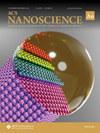Shape-Morphing of an Artificial Protein Cage with Unusual Geometry Induced by a Single Amino Acid Change
IF 4.8
Q2 NANOSCIENCE & NANOTECHNOLOGY
引用次数: 4
Abstract
Artificial protein cages are constructed from multiple protein subunits. The interaction between the subunits, notably the angle formed between them, controls the geometry of the resulting cage. Here, using the artificial protein cage, “TRAP-cage”, we show that a simple alteration in the position of a single amino acid responsible for Au(I)-mediated subunit–subunit interactions in the constituent ring-shaped building blocks results in a more acute dihedral angle between them. In turn, this causes a dramatic shift in the structure from a 24-ring cage with an octahedral symmetry to a 20-ring cage with a C2 symmetry. This symmetry change is accompanied by a decrease in the number of Au(I)-mediated bonds between cysteines and a concomitant change in biophysical properties of the cage.

由单个氨基酸变化诱导的具有不寻常几何形状的人工蛋白质笼的形状-变形
人工蛋白质笼由多个蛋白质亚基组成。子单元之间的相互作用,尤其是它们之间形成的角度,控制着最终笼子的几何形状。在这里,使用人工蛋白质笼,“陷阱笼”,我们表明,在组成的环状构建块中,负责Au(I)介导的亚基-亚基相互作用的单个氨基酸的位置的简单改变会导致它们之间更尖锐的二角角。反过来,这会导致结构从具有八面体对称的24环笼转变为具有C2对称的20环笼。这种对称性变化伴随着半胱氨酸之间Au(I)介导的键数的减少以及笼的生物物理性质的变化。
本文章由计算机程序翻译,如有差异,请以英文原文为准。
求助全文
约1分钟内获得全文
求助全文
来源期刊

ACS Nanoscience Au
材料科学、纳米科学-
CiteScore
4.20
自引率
0.00%
发文量
0
期刊介绍:
ACS Nanoscience Au is an open access journal that publishes original fundamental and applied research on nanoscience and nanotechnology research at the interfaces of chemistry biology medicine materials science physics and engineering.The journal publishes short letters comprehensive articles reviews and perspectives on all aspects of nanoscience and nanotechnology:synthesis assembly characterization theory modeling and simulation of nanostructures nanomaterials and nanoscale devicesdesign fabrication and applications of organic inorganic polymer hybrid and biological nanostructuresexperimental and theoretical studies of nanoscale chemical physical and biological phenomenamethods and tools for nanoscience and nanotechnologyself- and directed-assemblyzero- one- and two-dimensional materialsnanostructures and nano-engineered devices with advanced performancenanobiotechnologynanomedicine and nanotoxicologyACS Nanoscience Au also publishes original experimental and theoretical research of an applied nature that integrates knowledge in the areas of materials engineering physics bioscience and chemistry into important applications of nanomaterials.
 求助内容:
求助内容: 应助结果提醒方式:
应助结果提醒方式:


